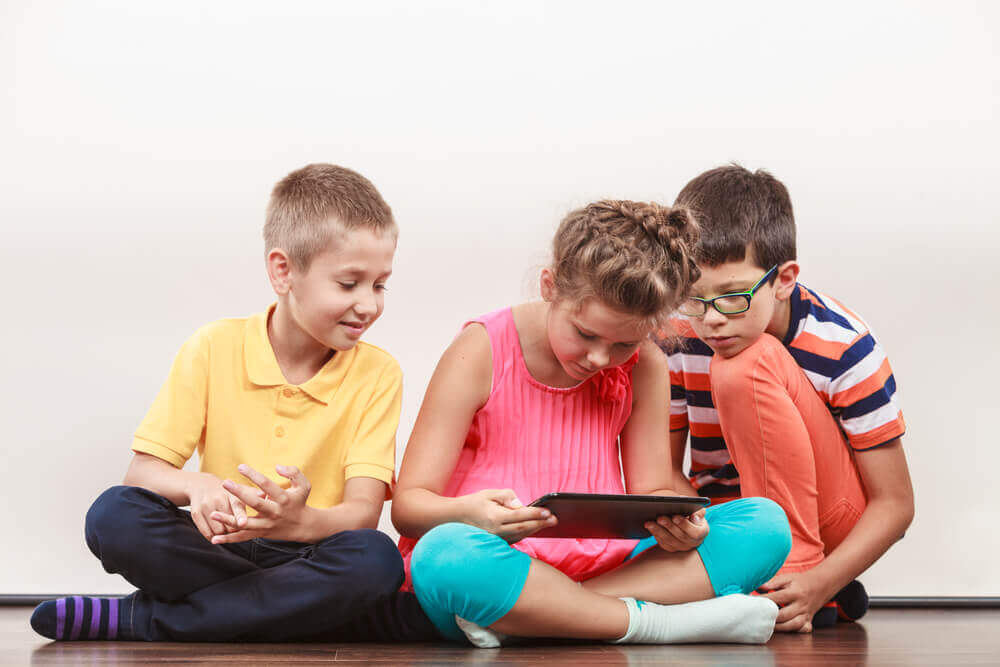What's the Best Age for Kids to Start Using Social Media?

What’s the best age for kids to start using social media? Social networks have become normal in the daily life of adults. In fact, most adults spend hours a day on them.
In addition to adults, it’s not surprising to see children between two and three years old using smart phones, tablets and computers. Additionally, kids around ages eight or nine want to start using social media.
Internet, and more specifically social networks, have lots of advantages for people. However, there are also lots of dangers that you may not be aware of. That’s why you might want to ask yourself: where should we set the limit?
Therefore, we’ll try and help you through this controversial issue about when kids should start using social media.
Children on social media
According to the UNICEF study “The State of the World’s Children 2017: Children in a Digital World,” one in three people surfing the internet is a child.
More specifically, in the United States, there isn’t a minimum age to start using social networks. Every social network has a different age requirement. However, this still doesn’t determine when the best age to start using social media is.
Many parents use the excuse that their children don’t have social media because they don’t have a cell phone, computer, or tablet to use.
Dear parents: nowadays, not having electronic devices isn’t a problem. If your child doesn’t have any, certainly one of his friends does. Additionally, making an account on one of the well-known social media sites takes no more than five minutes.
Therefore, we can say that children will start using social media when they want to, with or without your permission.

Recommendations for when children should start using social media
After coming to terms with the reality that kids will start whenever they want, we have some tips for you. It’s important to follow a few recommendations so that kids start using social media in the least dangerous way possible, and know how to use the internet safely.
Set a good example
We always say that children imitate everything they see. Therefore, before scolding your child for not using social media properly, you need to set a good example. Then, you can help your child when they make mistakes.
Explain its advantages and disadvantages
It’s important for kids to know from the beginning the different advantages that social media has. However, they also need to know the dangers.
Depending on your children’s age, you can use real examples of kids using social media to show them what can happen on the internet.
Therefore, they need to make sure they have a private account. Under no circumstances should their accounts be public.
Talk to your children so that they don’t provide personal information through these networks. Additionally, they shouldn’t add or talk to people that they don’t know.
Restrict times for when children can use social media
Children shouldn’t live attached to their electronic devices. Therefore, you should limit their use to when you think it’s appropriate.
Many parents only let their kids use social media on the weekend. Others say they can use it only one hour a day, and others only one day a week. You can set whatever limit you think is best.
Help your children identify cyberbullying
In addition to explaining the advantages and disadvantages of social media, you should make sure to mention the important problem of online harassment, better known as cyberbullying.
Children need to feel confident knowing that if they’re ever cyberbullied, they have the help and support of their parents. They also need to know to come to you immediately.

In conclusion, there isn’t a specific age for children to start using social media. You can’t really do much to stop them. However, you can teach them to surf the internet and manage their social networks responsibly and in the best possible way.
What’s the best age for kids to start using social media? Social networks have become normal in the daily life of adults. In fact, most adults spend hours a day on them.
In addition to adults, it’s not surprising to see children between two and three years old using smart phones, tablets and computers. Additionally, kids around ages eight or nine want to start using social media.
Internet, and more specifically social networks, have lots of advantages for people. However, there are also lots of dangers that you may not be aware of. That’s why you might want to ask yourself: where should we set the limit?
Therefore, we’ll try and help you through this controversial issue about when kids should start using social media.
Children on social media
According to the UNICEF study “The State of the World’s Children 2017: Children in a Digital World,” one in three people surfing the internet is a child.
More specifically, in the United States, there isn’t a minimum age to start using social networks. Every social network has a different age requirement. However, this still doesn’t determine when the best age to start using social media is.
Many parents use the excuse that their children don’t have social media because they don’t have a cell phone, computer, or tablet to use.
Dear parents: nowadays, not having electronic devices isn’t a problem. If your child doesn’t have any, certainly one of his friends does. Additionally, making an account on one of the well-known social media sites takes no more than five minutes.
Therefore, we can say that children will start using social media when they want to, with or without your permission.

Recommendations for when children should start using social media
After coming to terms with the reality that kids will start whenever they want, we have some tips for you. It’s important to follow a few recommendations so that kids start using social media in the least dangerous way possible, and know how to use the internet safely.
Set a good example
We always say that children imitate everything they see. Therefore, before scolding your child for not using social media properly, you need to set a good example. Then, you can help your child when they make mistakes.
Explain its advantages and disadvantages
It’s important for kids to know from the beginning the different advantages that social media has. However, they also need to know the dangers.
Depending on your children’s age, you can use real examples of kids using social media to show them what can happen on the internet.
Therefore, they need to make sure they have a private account. Under no circumstances should their accounts be public.
Talk to your children so that they don’t provide personal information through these networks. Additionally, they shouldn’t add or talk to people that they don’t know.
Restrict times for when children can use social media
Children shouldn’t live attached to their electronic devices. Therefore, you should limit their use to when you think it’s appropriate.
Many parents only let their kids use social media on the weekend. Others say they can use it only one hour a day, and others only one day a week. You can set whatever limit you think is best.
Help your children identify cyberbullying
In addition to explaining the advantages and disadvantages of social media, you should make sure to mention the important problem of online harassment, better known as cyberbullying.
Children need to feel confident knowing that if they’re ever cyberbullied, they have the help and support of their parents. They also need to know to come to you immediately.

In conclusion, there isn’t a specific age for children to start using social media. You can’t really do much to stop them. However, you can teach them to surf the internet and manage their social networks responsibly and in the best possible way.
All cited sources were thoroughly reviewed by our team to ensure their quality, reliability, currency, and validity. The bibliography of this article was considered reliable and of academic or scientific accuracy.
- Aydn, B. y Volkan Sar, S. (2011). Internet addiction among adolescents: the role of self-esteem.Procedia Social and Behavioral Sciences, 15, 3500–3505.
- Bringué, X. y Sádaba, C. (2011). Menores y redes sociales. Madrid: Foro generaciones interactivas.
- Calderón, C. A., López, M., & Peña, J. (2017). El efecto condicional indirecto de la expectativa de rendimiento en el uso de Facebook, Google+, Instagram y Twitter por jóvenes. Revista Latina de Comunicación Social, (72), 590-607. https://www.redalyc.org/pdf/819/81952828031.pdf
- Mattei, M. M. (2015). El divismo en tiempos de# Instagram. CIC. Cuadernos de Información y Comunicación, 20, 95-107. https://www.redalyc.org/pdf/935/93542537009.pdf
- Wang, N. y Yongqiang, S. (2015). Social influence or personal preference? Examining the determinants of usage intention across social media with different sociability. Information Development (2015): 0266666915603224.
This text is provided for informational purposes only and does not replace consultation with a professional. If in doubt, consult your specialist.








